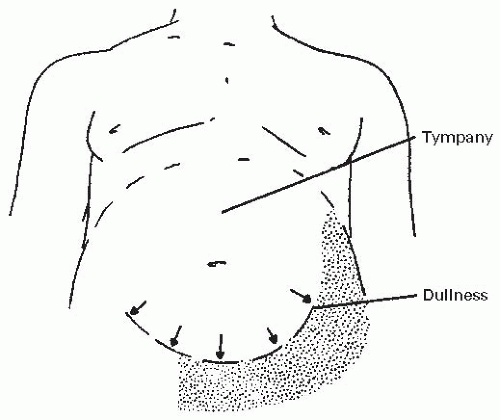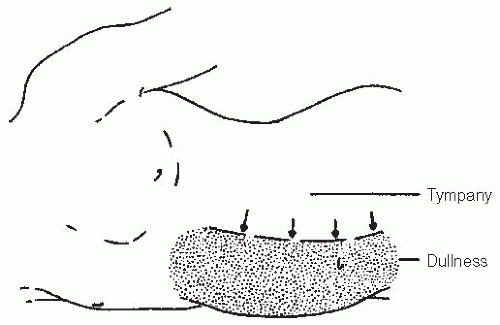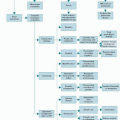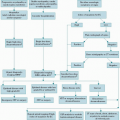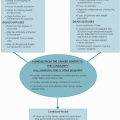For the majority of patients, the pharmacologic management of ascites is palliative. That is, the goal of therapy is to minimize symptoms and optimize quality of life without the expectation that the underlying cause can be reversed.
Systemic chemotherapy may be an effective management strategy for patients with malignant ascites due to a responsive cancer (e.g., lymphoma, breast, or ovarian cancer). In addition to systemic chemotherapy, intraperitoneal chemotherapy is an option. In theory, intraperitoneal chemotherapy can deliver high doses to peritoneal sites with minimal systemic side effects. In practice, intraperitoneal chemotherapy is often limited by uneven distribution and poor tissue penetration. Hyperthermic intracavitary chemotherapy after surgical debulking may overcome some of these limitations and enhance the cytotoxicity of chemotherapy (
20,
21). Biologically active agents have also been used intraperitoneally to treat malignant ascites. Early clinical trials have used interferon (IFN)-α, IFN-β, and IFN-γ, tumor necrosis factor, interleukin-2, anti-VEGF antibodies, anti-VEGF receptor antibodies, VEGF receptor tyrosine kinase inhibitors, and metalloproteinase inhibitors. To date, no phase III clinical trials have been performed. Overall, the efficacy and role of intraperitoneal chemotherapeutic and biologic agents in both curative and palliative care remain to be determined.
Diuretic therapy could be useful in patients whose ascites has a high SAAG, as opposed to low SAAG ascites that is typically diuretic unresponsive. As with any drug therapy in the supportive care setting, the patient’s symptoms should first be ascertained and the benefit versus the burden of therapy considered. The goal of diuretic therapy is to reduce extravascular fluid accumulation. Diuretic therapy should be directed to achieve a slow and gradual diuresis that does not exceed the capacity for mobilization of ascitic fluid. In the patient with ascites and edema, edema acts as a fluid
reservoir to buffer the effects of a rapid contraction of plasma volume. Approximately 1 L/d (net) can safely be diuresed. In patients with ascites but without edema, diuresis may be achieved at the expense of the intravascular volume, leading to symptomatic orthostatic hypotension. In these patients, a more modest goal is to achieve net diuresis of 500 mL/d. Diuretics should not be administered with the goal to render the patient free of edema and ascites. Rather, only enough fluid should be mobilized to promote the patient’s comfort. Overly aggressive diuretic therapy for ascites in a patient with high SAAG ascites has been associated with the hepatorenal syndrome and death (
22).
For patients with high SAAG ascites in whom diuretics may be helpful, the renin-angiotensin-aldosterone system is activated. Therefore, the initial diuretic of choice for management is one that acts at the distal nephron to block the effect of increased aldosterone activity (
23,
24). Spironolactone, an aldosterone receptor antagonist, is a first-line therapy. Dosing begins at 100 mg/d and can be titrated up to effect or a maximum of 400 mg/d (
Table 16.2). Given spironolactone’s long half-life, daily dosing is sufficient. Spironolactone may cause painful gynecomastia (
25). Amiloride hydrochloride, 10 mg/d, is an alternative. It acts faster and does not cause gynecomastia. It can be titrated up to a dose of 40 mg/d. Because these diuretics are relatively potassium sparing, patients should be advised not to use salt substitutes, as these are usually preparations of potassium chloride. If patients have a suboptimal response despite maximal use of the distal diuretics, a loop diuretic may be added, beginning at low doses (e.g., furosemide, 40 mg orally daily). There is evidence to support the combined use of a distal tubule diuretic and a loop diuretic at the beginning of therapy (
24). This combination may effect a more rapid diuresis while maintaining potassium homeostasis. A ratio of 100 mg of spironolactone to 40 mg of furosemide is recommended as a starting point (
1). The ratio can be adjusted to maintain normokalemia. The dosages can be increased in parallel until the goals of therapy have been attained, up to a maximum of spironolactone, 400 mg/d, and furosemide, 160 mg/d, or until therapy is limited by side effects (
1). If there is no response to this level of therapy, the ascites is considered refractory to diuretic therapy if the following are true: (a) salt intake is appropriately limited and (b) nonsteroidal anti-inflammatory medications, which can affect glomerular filtration, are not being used.



